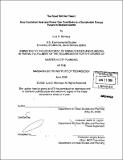The road still not taken : how combined heat and power can contribute to a sustainable energy future in Massachusetts
Author(s)
Montoya, Luis D. (Luis Daniel)
DownloadFull printable version (2.654Mb)
Alternative title
How combined heat and power can contribute to a sustainable energy future in Massachusetts
Other Contributors
Massachusetts Institute of Technology. Dept. of Urban Studies and Planning.
Advisor
Judith A. Layzer.
Terms of use
Metadata
Show full item recordAbstract
In order to address rising energy costs and global climate change, Massachusetts has adopted greenhouse gas reduction goals and implemented programs and policies to promote the clean and efficient use of energy. Despite these efforts, however, the rate of development of distributed generation (DG) in the state pales in comparison to that of traditional centralized generation facilitates. DG is the production of electricity at or near the location where it will be used. Instead of relying on power generated at large, centrally located facilities and distributed over long transmission lines, DG customers use small, modular generators to produce the power they use. DG units can generate electricity using wind turbines, solar panels, fuel cells, gas powered microturbines or other combustion engines. One class of DG, combined heat and power (CHP), has the immediate potential to accelerate DG growth and drastically improve the efficiency of electricity production. But technical and regulatory barriers associated with interconnection to the electricity grid and general project management challenges inhibit the wide-scale development of CHP. This thesis argues that although Massachusetts has worked hard to bring together members of the public and private sectors to address multiple barriers to DG, specific technical, regulatory, and logistical barriers continue to hinder the ability of Massachusetts energy customers to realize the potential economic and environmental benefits of DG, and CHP specifically. Case studies of CHP projects in Massachusetts are used to illustrate the variety of barriers facing potential CHP customers in the state and how public policy interventions can address those barriers.
Description
Thesis (M.C.P.)--Massachusetts Institute of Technology, Dept. of Urban Studies and Planning, 2008. Includes bibliographical references (p. 50-56).
Date issued
2008Department
Massachusetts Institute of Technology. Department of Urban Studies and PlanningPublisher
Massachusetts Institute of Technology
Keywords
Urban Studies and Planning.